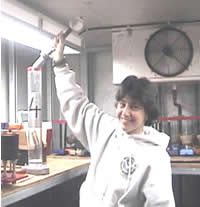|
Participant Perspective - July
18, 2001
 Interview
with Ana Metaxas Interview
with Ana Metaxas
Biological Oceanographer
Jeff:
What are you studying at Axial Volcano?
Anna:
I'm interested in the period between when larvae are released into the
water column and when they are recruited back to the benthic population.
Also, I'm interested in why they settle in a particular location. The
site may have other adults, the right chemistry or substrate texture.
I want to put down larval traps to look at larval abundance in the water
column and an array to see where they actually settle at different sites
at Axial. We're not looking for a specific type of larvae. Last year we
got a lot of limpets and some polycheate worms. We're probably going to
get gastropods and we should get tube worms if it's in the right area.
Jeff:
How do your larval traps work?
Anna:
I have two types. One is a passive larval trap. They are basically tubes
filled with formalin (a poison) and as water moves over the top of the
cylinder it forms a small eddy that traps things and transports them into
the cylinder. They hit the poison and fall to the bottom. The traps give
us an idea of what type of larvae are transported near the bottom. We
also have settlement array instruments. They are basically soap dishes
with substrates that are supposed to mimic the bottom and attract the
larvae so they stick on them and stay there. We
have two kinds of substrates. One is basalt because that's the type of
rock at Axial. The other are Scotch Brights (scrubbies). The reason the
scrubbies are so successful is that they have a lot of structure to them.
Anything that comes to settle wants to stay away from currents in little
holes and cracks so things can't eat them. We'll leave the traps down
for 10 days and the arrays we'll leave down for one and two years.
Jeff:
Is vent larval dispersal one of the hardest things to study at vent areas?
Anna:
Yes. A study on tube worm larvae dispersal based on respiration rates
at
the East Pacific Rise suggests that they don't feed, so whatever energy
they
have has come from the egg. They estimated that they can live up to 36
days. They calculated, based on currents, how far the larvae can be transported
in 36 days. The farthest they could get is 105 km, although most of them
can get about< 50 to 60 km which would barely get them to the next vent.
So, they can't go very< far. It also suggests, because currents rotate,
that a lot of the larvae get transported off axis and presumably they
are lost. That could be 40 - 70 % of larvae just disappearing off axis,
given the current. It's not very easy to get from vent to vent.
Jeff:
What about larval dispersal in hydrothermal vent plumes?
Anna:
I have a hard time believing that theory now that water column samples
have been taken and large larvae densities haven't shown up in the plume.
We're talking 1 to 2 individuals per m3 or 10 m3. If they can only get
to the next vent, I don't know if that could work. Larval dispersal is
the hardest problem to work with because we don't know that much about
dispersal mechanisms. It has been suggested that larvae get released from
a vent area and entrained into a plume. They rise to where the plume becomes
neutrally buoyant then, as the plume is traveling up and down the ridge,
little plumes with concentrated larvae get separated from the large plume
and those larvae move onto the next vent and then drop. I don't know if
I believe that.
Jeff:
What do you find most fascinating about studying larvae dispersal?
Anna:
I think that larvae actually have behaviors, show behaviors and show some
responses to their environment which I don't think people think about
that much. If you think of really big scales, larvae are just particles
that are transported in currents. I think when we get to smaller scales
larvae actually show behavioral responses to their environment and I think
that is really neat. I've done lab experiments that show that larvae respond
to food patches. They will stop and feed at a food patch. When larvae
settle we know they respond to chemicals, to conspecifics. Despite their
simple structures, they do have behaviors that suggest they sense their
environment and that increases their chances of survival and that's really
neat. We don't think about them. They are just particles in the water
column. I don't think they are just little particles, they do things (laughter).
|

